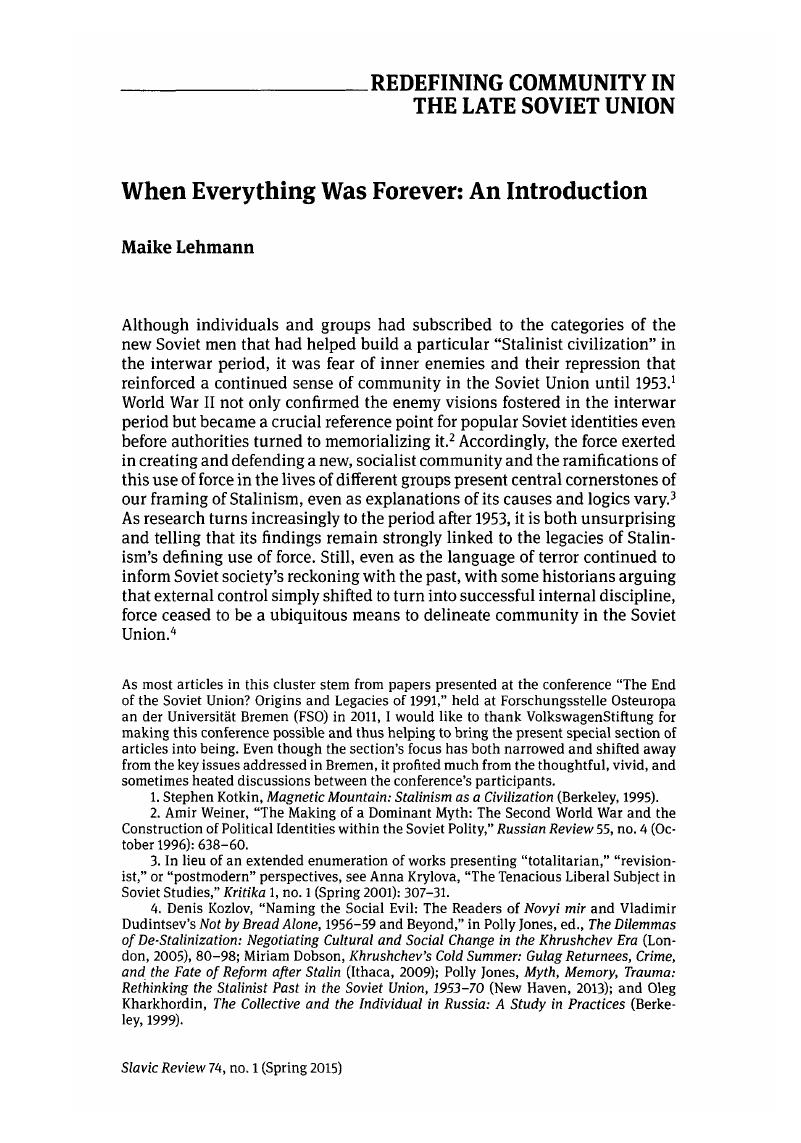Article contents
When Everything Was Forever: An Introduction
Published online by Cambridge University Press: 20 January 2017
Abstract

- Type
- Redefining Community in the Late Soviet Union
- Information
- Copyright
- Copyright © Association for Slavic, East European, and Eurasian Studies. 2014
References
1. Kotkin, Stephen, Magnetic Mountain: Stalinism as a Civilization(Berkeley, 1995).Google Scholar
2. Weiner, Amir, “The Making of a Dominant Myth: The Second World War and the Construction of Political Identities within the Soviet Polity,” Russian Review 55, no. 4 (October 1996): 638–60.CrossRefGoogle Scholar
3. In lieu of an extended enumeration of works presenting “totalitarian,” “revisionist,“ or “postmodern” perspectives, see Krylova, Anna, “The Tenacious Liberal Subject in Soviet Studies,” Kritika 1, no. 1 (Spring 2001): 307–31.Google Scholar
4. Kozlov, Denis, “Naming the Social Evil: The Readers of Novyi mirand Vladimir Dudintsev's Not by Bread Alone,1956-59 and Beyond,” in Jones, Polly, ed., The Dilemmas of De-Stalinization: Negotiating Cultural and Social Change in the Khrushchev Era(London, 2005), 80–98;Google Scholar Dobson, Miriam, Khrushchev's Cold Summer: Gulag Returnees, Crime, and the Fate of Reform after Stalin(Ithaca, 2009)Google Scholar; Jones, Polly, Myth, Memory, Trauma: Rethinking the Stalinist Past in the Soviet Union, 1953-70(New Haven, 2013)CrossRefGoogle Scholar; and Kharkhordin, Oleg, The Collective and the Individual in Russia: A Study in Practices(Berkeley, 1999).Google Scholar
5. Most recently, Denis Kozlov and Eleonory Gilburd have pointed out how fitting the thaw's weather metaphor nevertheless is, not only because contemporaries themselves regarded it as a constitutive event and appropriate expression of the Zeitgeist, but also because of the processual and indeterminate character of this weather condition. Kozlov, Denis and Gilburd, Eleonory, “The Thaw as an Event in Russian History,” in Kozlov, Denis and Gilburd, Eleonory, eds., The Thaw: Soviet Society and Culture during the 1950s and 1960s(Toronto, 2013), 18-23,30–32.Google Scholar See also the contributions in Jones, , ed., The Dilemmas of De-Stalinization,and “The Relaunch of the Soviet Project, 1945-64,” ed. Fiirst, Juliane, Jones, Polly, and Morrissey, Susan, special Issue, Slavonic and East European Review 86, no. 2 (April 2008).Google Scholar
6. Gorsuch, Anne E. and Koenker, Diane P., eds., The Socialist Sixties: Crossing Borders in the Second World(Bloomington 2013).Google Scholar
7. Vail, Petr’ and Genis, Aleksandr, 60-e: Mir sovetskogo cheloveka,3rd ed. (Moscow, 2001).Google Scholar
8. Zubok, Vladislav, Zhivago's Children: The Last Russian Intelligentsia(Cambridge, Mass., 2009).Google Scholar See also Beyrau, Dietrich, Intelligenz und Dissens: Die russischen Bildungsschichten in der Sowjetunion, 1917-1985(Gottingen, 1993);Google Scholar and Alexeyeva, Ludmilla, The Thaw Generation: Coming of Age in the Post-Stalin Era(Pittsburgh, 1993).Google Scholar
9. Yurchak, Alexei, Everything Was Forever, Until It Was No More: The Last Soviet Generation (Princeton, 2006), 14-16, 26-27, 47–48.Google Scholar
10. Ibid., 23, 28.
11. Ibid., 4.
12. Piatt, Kevin M. F. and Nathans, Benjamin, “Socialist in Form, Indeterminate in Content: The Ins and Outs of Late Soviet Culture,” Ab Imperio,no. 2 (2012): 316.Google Scholar
13. Raleigh, Donald, Soviet Baby Boomers: An Oral History of Russia's Cold War Generation (Oxford, 2013).Google Scholar
14. Nathans, Piatt, “Socialist in Form,” 319.Google Scholar
15. Piatt, Kevin M. F. and Natans, Bendzhamin [Benjamin Nathans], “Sotsialisticheskaia po forme, neopredelennaia po soderzhaniiu: Pozdnesovetskaia kul'tura i kniga Alekseia Iurchaka, Vse bylo navechno, poka ne konchilos' ,”trans. Movnina, N., Novoe literaturnoe obozrenie,no. 101 (2010): 167–84.Google Scholar
16. Durkheim, fimile, Über soziale Arbeitsteilung: Studie über die Organisation hoherer Gesellschaften,3rd ed. (Frankfurt, 1999), 102,183,228,285–86.Google Scholar
17. On community and society as intertwined processes, see Weber, Max, Wirtschaft und Gesellschaft: Grundriß der verstehenden Soziologie,5th rev. ed. (Tubingen, 1990)Google Scholar, esp. § 9, “Vergemeinschaftung und Vergesellschaftung.“
18. Note also the interest in morality and emotions as crucial factors of social cohesion articulated by the functionalist founding father of sociology. Durkheim, Über soziale Arbeitsteilung,76,82.
19. For examples of communities’ views, beliefs, and wishes being negotiated and integrated within the broader Soviet project in the Stalinist period, see Alexopoulos, Golfo, Stalin's Outcasts: Aliens, Citizens, and the Soviet State, 1926-1936(Ithaca, 2003);Google Scholar and Dunham, Vera S., In Stalin's Time: Middleclass Values in Soviet Fiction(Cambridge, Eng., 1976; Durham, 1990).Google Scholar
20. Tumarkin, Nina, The Living and the Dead: The Rise and Fall of the Cult of World War II in Russia(New York, 1994).Google Scholar
21. Oushakine, Serguei, “The Terrifying Mimicry of Samizdat,” Public Culture 13, no. 2 (Spring 2001): 191–214.CrossRefGoogle Scholar
22. On the renewed interest in the role of the individual, see the programs of recent conferences on the matter, such as “After Stalin: Subjectivity in the Late Soviet Union (19531985),” organized by Anatoly Pinsky at the European University at St. Petersburg, April 25-16, 2014.
23. On standardized enactments of a hypernormalized Soviet ritual, cf. again Yurchak, Everything Was Forever,51, and chap. 3, “Ideology Inside Out: Ethics and Poetics.“
- 2
- Cited by


